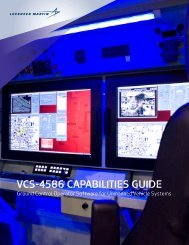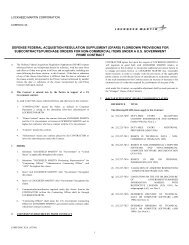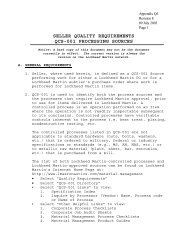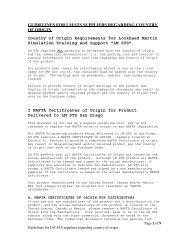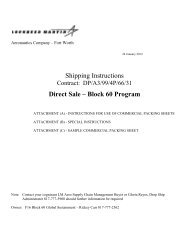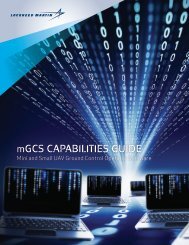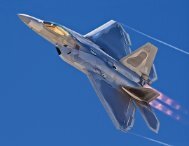You also want an ePaper? Increase the reach of your titles
YUMPU automatically turns print PDFs into web optimized ePapers that Google loves.
<strong>ALEX</strong><br />
Automatic Launch of EXpendables System for Ship Self-Defense
The <strong>ALEX</strong> system<br />
provides ship self-defense for 52 ships<br />
for eight international navies, including the U.S. Navy’s<br />
newest warship, the Littoral Combat Ship.<br />
The Need for Self Protection<br />
Off-board countermeasures protect surface navy assets against<br />
the ever-expanding threats of modern warfare and stand as a<br />
necessary part of any ship’s layered, self-defense.<br />
Countermeasure techniques include:<br />
• Hard-kill weapons to blunt or destroy the<br />
attacking forces<br />
• Soft-kill on-board ECM<br />
• Off-board decoys to seduce, distract, and confuse<br />
attacking forces<br />
Off-board decoys provide the lowest risk and offer the most<br />
cost effective method to aid in ship survival. Off-board<br />
decoys can easily be upgraded and adapted to pace the<br />
emergent and evolving ASM threat.<br />
<strong>ALEX</strong> (Automated Launch of EXpendables)<br />
• Off-board tactics for decoy use are complex<br />
• Result: A decoy launch system (DLS) operator, in<br />
combat conditions, is unable to assimilate all necessary<br />
data and then quickly execute the best decoy<br />
deployment tactics<br />
• To overcome this deficiency, <strong>Lockheed</strong> <strong>Martin</strong> developed<br />
the <strong>ALEX</strong> System<br />
• <strong>ALEX</strong> executes approved, predetermined decoy launch<br />
tactics, developed by the user navy employing TAWS<br />
software, either automatically or semi-automatically,<br />
depending upon the operational mode selected<br />
<strong>ALEX</strong> (Automatic Launch of EXpendables) System<br />
<strong>ALEX</strong> Features<br />
<strong>ALEX</strong> provides shipboard management of expendable decoys<br />
via computer control, using deck-mounted decoy launchers.<br />
• <strong>ALEX</strong> components take advantage of COTS technology<br />
• <strong>ALEX</strong> is integrated with the ship’s CMS, as well as<br />
ESM/NAV/Wind sensors<br />
• <strong>ALEX</strong> provides and implements optimum tactics for all<br />
scenarios<br />
• <strong>ALEX</strong> may be operated in an automatic or a semi-automatic<br />
mode. Manual override is available at all times, regardless of<br />
the operating mode selected.<br />
• <strong>ALEX</strong> is scalable, allowing the number of launchers to<br />
increase as ship size increases<br />
• <strong>ALEX</strong> provides:<br />
- Automatic decoy cartridge reseed<br />
- Automatic Misfire Detect/Correct<br />
- Built in Test<br />
<strong>ALEX</strong> uses either 130mm SRBOC or 112mm RBOC launchers<br />
and is fully compatible with both SRBOC (and RBOC) families<br />
of decoys. These RF, IR, hybrid RF-IR, and anti-torpedo decoys<br />
may be supplied by multiple international suppliers.<br />
Integrated Soft-Kill Solution<br />
<strong>ALEX</strong> could serve as the basis for integration for all off-board<br />
countermeasures, avoiding mutual interference/interaction<br />
among existing and future active and passive soft kill and hard<br />
kill systems.<br />
MK 137<br />
SRBOC LAUNCHERS<br />
MASTER CONTROL<br />
PANEL<br />
LAUNCHER<br />
ELECTRONICS UNIT<br />
MASTER POWER<br />
PANEL<br />
SYSTEM<br />
PROCESSOR<br />
UNINTERRUPTIBLE<br />
POWER SUPPLY<br />
SHIP MANEUVER<br />
INDICATORS<br />
BRIDGE CONTROL<br />
PANEL<br />
Cover photo credits:<br />
Top: SRBOC decoy launched from an <strong>ALEX</strong>-standard Mk 137 launcher on a United States Navy combatant<br />
Bottom: U.S. Navy petty officer undergoing <strong>ALEX</strong> operator training at the Marion, Ma. <strong>Lockheed</strong> <strong>Martin</strong> facility<br />
Cover photos courtesy of the U.S. Navy
I<br />
Test<br />
TUBE STATUS<br />
System Configuration<br />
The <strong>ALEX</strong> System, depicted below,<br />
consists of:<br />
• Deck-mounted launchers (one or<br />
more pairs, dependent upon ship size)<br />
• Launcher Electronics Units (LEU)<br />
One LEU per pair of launchers. The<br />
LEU communicates with the <strong>ALEX</strong><br />
SP over the serial digital <strong>ALEX</strong> LAN<br />
to implement decoy firing commands<br />
and report on launcher status<br />
including, loaded/empty, safe/armed<br />
and fire/misfire conditions.<br />
• System Processor (SP) This processor<br />
runs <strong>ALEX</strong> software under the state<br />
of the art operating system, QNX.<br />
It communicates with ship systems<br />
and manages decoy launching and<br />
operator inputs using one of a<br />
number of serial digital interfaces.<br />
• Master Control Panel (MCP).<br />
The MCP, the primary operator<br />
interface for <strong>ALEX</strong>: displaying<br />
system status of launchers, threat<br />
tracks and platform data. It receives<br />
operator commands to control decoy<br />
launching and implement automatic<br />
tactics.<br />
• Bridge Control Panel (BCP), is a<br />
manually operated alternative to the<br />
MCP. It contains safing, arming, and<br />
fire control switches as well as<br />
system status indicators. The <strong>ALEX</strong><br />
operator can award control of the<br />
<strong>ALEX</strong> System to the BCP from the<br />
MCP.<br />
• Ship Maneuver Indicator (SMI) also<br />
interfaces with the SP. An audible<br />
alarm on the SMI provides an alert<br />
when a recommended course-to-steer<br />
is displayed as part of the<br />
recommended decoy tactic.<br />
• Master Power Panel (MPP)<br />
The data and power circuits to<br />
all <strong>ALEX</strong> modules are routed<br />
through, and can be controlled with,<br />
the circuit breakers on the MPP.<br />
• Launcher warning horns are mounted<br />
in the vicinity of the launchers and<br />
sound at predetermined intervals<br />
whenever the system is in the “Enable<br />
Fire” mode.<br />
• Uninterruptable Power Supply (UPS)<br />
provides conditioned AC power to the<br />
system and, without operator<br />
intervention, will continue to supply<br />
backup power in the event of a ship<br />
power failure or a decrease in power<br />
level.<br />
Tactical Analysis Workstation<br />
(TAWS)<br />
TAWS is a soft kill ship defense<br />
modeling and analysis tool, developed<br />
by <strong>Lockheed</strong> <strong>Martin</strong>, to assist<br />
international customers in developing<br />
their own unique expert decoy launch<br />
tactics.<br />
TAWS may be operated in one of two<br />
modes – Automatic or Manual:<br />
Automatic mode<br />
• Runs user-directed parametric<br />
engagement analyses to produce the<br />
<strong>ALEX</strong> System Mission Data File<br />
(MDF)<br />
• MDF contains tactics to be used by<br />
the <strong>ALEX</strong> Operational Shipboard<br />
System<br />
• MDF is downloaded into <strong>ALEX</strong> SP,<br />
before the ship deploys, to “tailor”<br />
that ship with specific tactics for<br />
layered ship self-defense<br />
Manual mode<br />
• Runs individual scenarios with full<br />
animation<br />
Total Systems Support<br />
<strong>Lockheed</strong> <strong>Martin</strong> offers total customer<br />
support, from initial inquiry through<br />
LAUNCHER<br />
COMBAT<br />
SYSTEM<br />
COMBAT<br />
SYSTEM<br />
ESM<br />
PORT<br />
HORN<br />
LAUNCHER<br />
ELECTRONICS UNIT<br />
LAUNCHER STATUS, TACTIC DATA<br />
SYSTEM<br />
PROCESSOR<br />
SHIP DATA<br />
WIND DATA<br />
THREAT DATA<br />
OOU (SYNCHROS)<br />
THREAT DATA<br />
LAUNCHER<br />
PORT<br />
MASTER<br />
CONTROL<br />
PANEL<br />
final acceptance test, and most<br />
importantly, post delivery in-service<br />
support. Specific areas include:<br />
• Hardware Supply<br />
• Program Management<br />
• Production<br />
• Engineering Services<br />
• Support Services<br />
• Training<br />
• Integrated Logistics Support<br />
• Post Delivery In-Service Support<br />
HORN<br />
LAUNCHER<br />
ELECTRONICS UNIT<br />
HORN<br />
SHIP<br />
MANEUVER<br />
INDICATOR<br />
LAUNCHER<br />
STARBOARD<br />
UNINTERRUPTABLE<br />
POWER SUPPLY<br />
HORN<br />
1 2<br />
3 4<br />
MASTER<br />
POWER PANEL<br />
LAUNCHER<br />
STARBOARD<br />
SHIP’S POWER<br />
BRIDGE<br />
CONTROL<br />
PANEL
<strong>Lockheed</strong> <strong>Martin</strong><br />
Mission Systems and Training<br />
300 M Street, SE<br />
Washington, D.C. 20003, USA<br />
www.lockheedmartin.com/mst/product_contacts<br />
Copyright © 2013 <strong>Lockheed</strong> <strong>Martin</strong> Corporation<br />
All rights reserved




